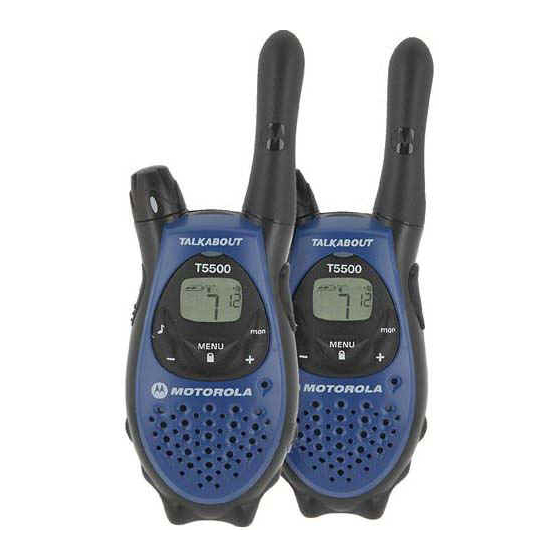Motorola TALKABOUT T5500 Manual de Comunicações - Página 10
Procurar online ou descarregar pdf Manual de Comunicações para Rádio Motorola TALKABOUT T5500. Motorola TALKABOUT T5500 16 páginas. Frs/gmrs recreational two-way radios
Também para Motorola TALKABOUT T5500: Manual do utilizador (36 páginas), Manual do utilizador (17 páginas), Manual do utilizador (5 páginas)

PROPER USE OF YOUR RADIO IN CERT ACTIVITIES
1)
Holding your HT
• The radio should be about 2- 3 inches from your mouth and not right up against
your mouth. Every radio is different and you should test your own to see what
distance is best by having another person listen to you from a few hundred feet
and reporting back what sounds best.
• Your radio should be turned 30-45 degrees from your face so "gusts" of air from
your mouth slide by. This increases the intelligibility of your transmissions.
• Keep your antenna pointing almost straight up. Radios work better if the
transmitting and receiving antennas are parallel to each other. Keep your antenna
from touching anything, especially metal. It robs power from the signal.
• Do not put your antenna right up against your body, particularly your head. Keep
it 3+ inches away. There are concerns that there may be negative health effects
from doing that and it saps power from your signal. Do not use when close to a
pacemaker.
2) Speech
• Speak in a normal voice.
• Too close or to loud causes distortion while too soft or too far away makes it hard
to hear the weak sound.
• Use plain English (avoid "10 codes" and radio jargon).
• Speak slowly, enunciate clearly, especially is there is difficulty getting through.
• Use phonetics if necessary to be understood (use first names like Andrew,
Barbara, Charlie, for A, B and C, etc.).
• Avoid areas with a lot of background noise (near a busy road, near a generator).
3) Operating practices:
• Before transmitting make sure that the frequency (channel) you want to use is
clear by listening for a few seconds BEFORE using it.
• Each new series of transmission should start by stating who you are calling
followed by "this is" or "from" followd by your tactical call sign (e.g.
"Command Communications, this is "Search Team Alpha")
• Then "Do you copy?"
• The response should be ""Search Team Alpha, this is Command
Communications, Roger, go ahead. "Roger" means "received" Roger does
not mean or imply "I will comply". If that is what you mean say "wilco" (for
"will comply").
• The response need always not begin by repeating who you are calling and
who you are unless radio conditions are difficult and identification required
for purposes of making sure each station knows with whom they are
communicating.
For disaster communication in the ASNC area, tune to FRS Channel 2 (Alternate: Ch 12)
Ham Radio Operators should also tune to Battalion 2 simplex 145.585 MHz, PL 110.9
*
10
